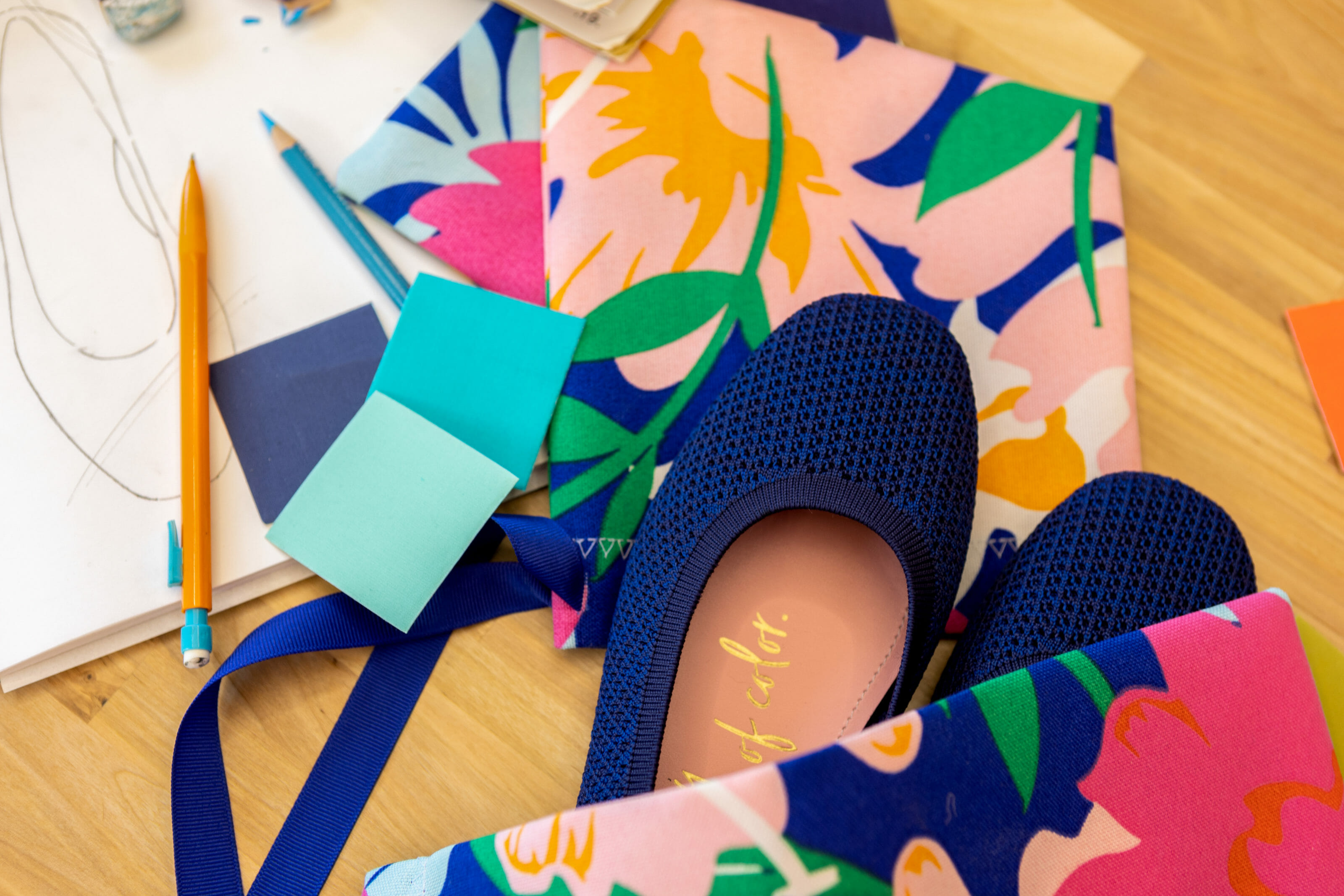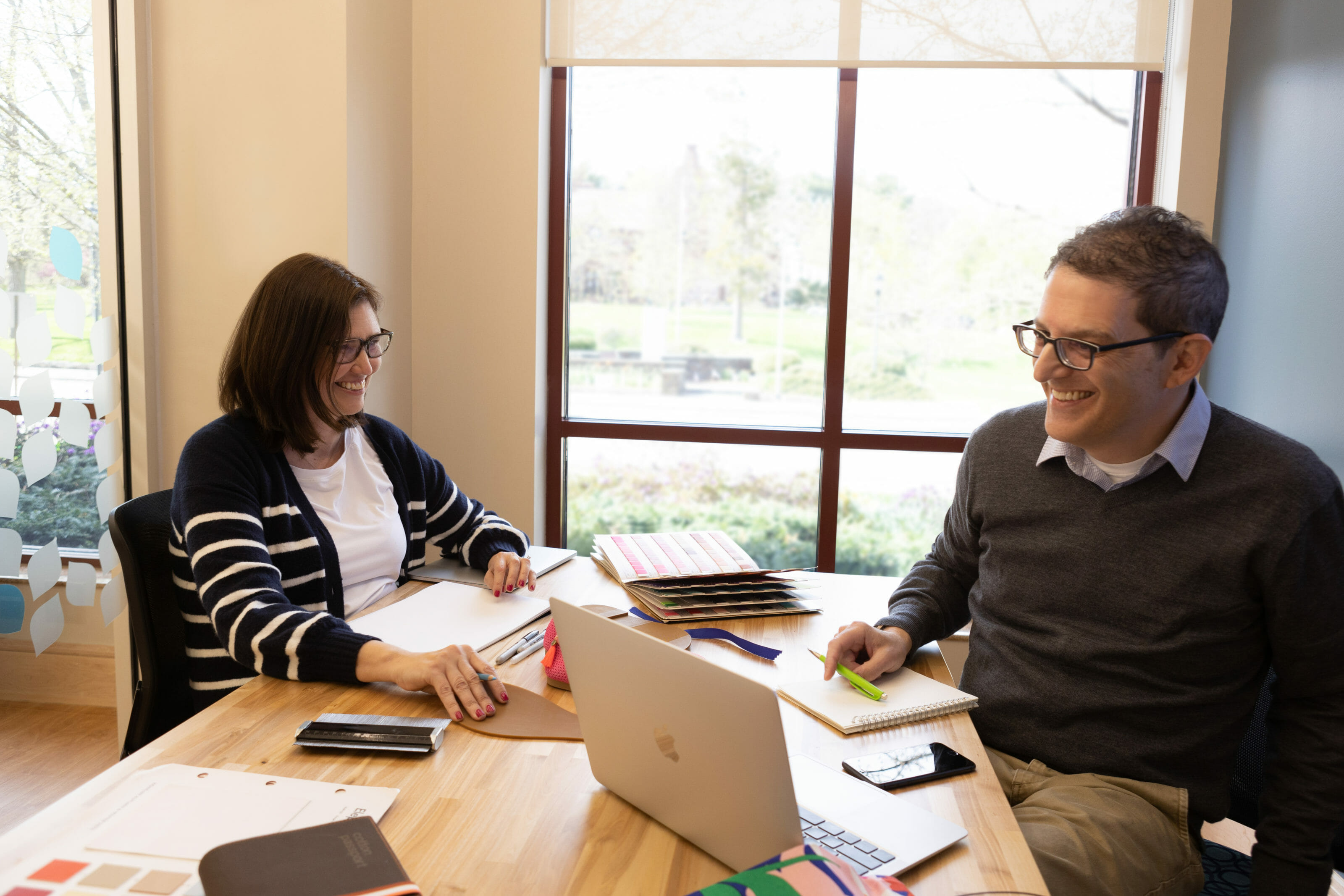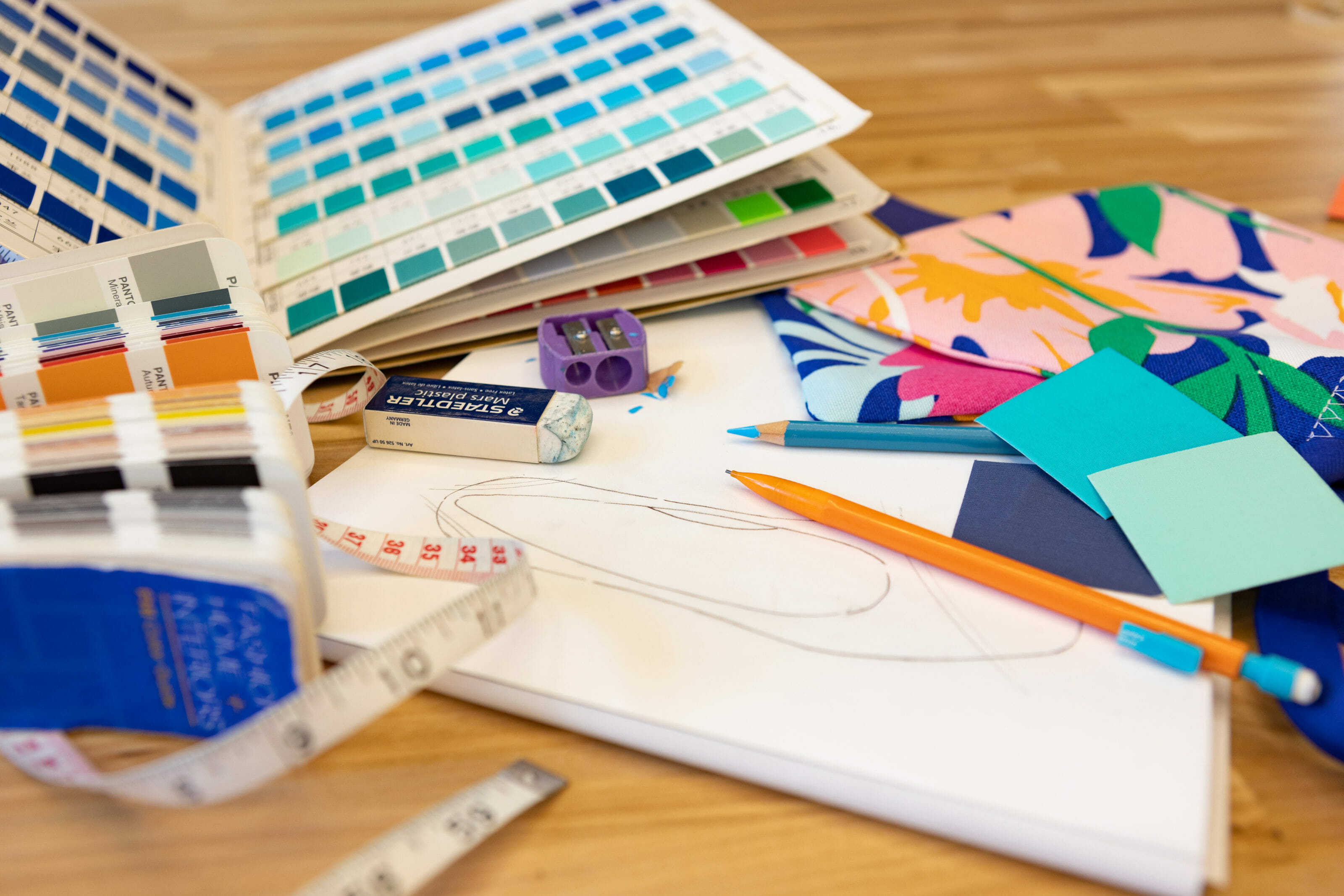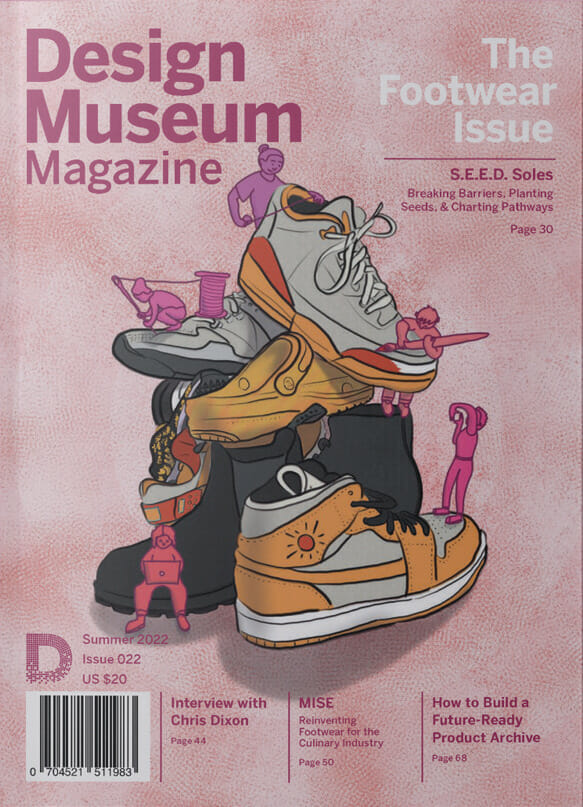Designing for a Cause: One Colorful Step at a Time

By Ann Williams, Creative Director – Product Design and Project Management, & Dean Schwartz, Co-Director
We’ve always believed that emotion and purpose are at the heart and soul of great design. When we established Schwilliamz in 2003, we brought this philosophy to a broader market, tapping into what we saw as an unmet demand in the footwear industry for design and strategy consulting services beyond what the typical freelancer might offer. Rather than just draw on demand, our aim was to offer clients all the benefits and capabilities of a full-service in-house design team without the long-term commitment and expense of maintaining a full-time department. We named ourselves Schwilliamz as a some-what tongue in cheek mashup of our surnames, aimed at conveying our unique combination of skills and experience.
Before Schwilliamz, Ann graduated with an Honorary Degree in Footwear Design from DeMontfort University in Leicester, England and gained extensive footwear industry experience working in the USA and the UK. An award-winning designer with an exceptional working knowledge of all facets of the footwear industry, Ann has a demonstrated ability to manage multiple major international projects and staff. Drawing on a liberal arts degree from Colby College and a background in advertising and retail, Dean monitors market and industry trends and is actively involved in the footwear design and development process, from product, market, and consumer research and insight to material, color, and prototype specifications.
It is the complementary combination of these experiences and capabilities that enables us to meet our clients’ needs quickly and seamlessly, whether it’s to supplement an in-house design team, provide a fresh perspective, enable expansion into new categories, or oversee the entire footwear design and development process.
Every so often, a design project perfectly aligns creative passion and technical skills with a deeper sense of meaning, and you realize that what drives you isn’t just professional attainment and commercial success, but also the understanding that somehow, on some scale small or large, what you do makes a difference in people’s lives.
Such was the case several months into lock-down when we were contacted by Lisa Carlin. Networking led Lisa to us, via a footwear industry leader with whom we’ve worked consistently over the years. We were immediately taken by Lisa’s positivity and upbeat personality, and we were genuinely intrigued by her concept of pairing footwear with her inspirational personal story and pledge to support others with similar experiences.
A few years ago, the mother of two young girls was thrown into a battle waged by 1 in 8 U.S. women: fighting breast cancer. Facing a double mastectomy, 8 doses of chemotherapy, and 6 weeks of radiation, 5 days a week, Lisa turned to an unlikely source for strength: a pair of hot pink ballet flats. Dreading the sterile hospital that she knew would become her home for several months, Lisa decided the old pair of ballets would adorn her feet every time she walked through the doors. “The bright hot pink color lifted my spirits, and always sparked conversation with other patients, nurses, and doctors. They gave me the feeling that I could power through what-ever was going to come my way.”
This sentiment really resonated with us. As designers, it’s no doubt great to receive positive feedback on a shoe’s aesthetics or comfort, but it’s truly wonderful when you learn your work brings confidence and a smile to someone.
Lisa fought and ultimately defeated breast cancer “one colorful step at a time.” She turned to us to help her create footwear that spread a feeling of empowerment and encouragement to other women fighting their fight now, just as the original pink ballet flats had done for her. The brand would be called “Poppies w/ Purpose™,” inspired by the quilt Lisa’s mother hand-stitched for her to use during treatments. The quilt was made from her great-grandmother’s “house coat” from the 1940’s, colorful fabric covered with bright poppy flowers. Continuing the theme, the brand’s tagline is “Live each day with a bit of fight and a pop of color.” Lisa had a pretty clear idea in her mind as to how she wanted the brand and shoe to look and feel, but she needed help making her vision a reality. This project was driven by a personal, emotional story and philosophy, rather than sales numbers. With her pitch document as our jumping off point, the three of us worked together to define and design a ballet flat with a cause.
As a Strategic Relationship Executive with MillerKnoll, Lisa had no footwear industry experience and needed a design partner who was not only highly creative, but also would help her navigate the arcane footwear development process and thrive in an increasingly challenging marketplace.

Over the past 19 years, we’ve developed and fine-tuned a footwear design and development process that is accessible and applicable to established global brands and startups alike. In our experience, the basic framework is effectively the same across all categories, from first walkers and casual sneakers to hiking boots and high heeled pumps, whether designed with sketch pads and pencils or rendering software.
We recognize that each client is unique and that every project is different, and we tailor our process accordingly. By guiding them through clearly defined steps covering research and analysis, strategy, design and creative, prototyping and development, the client is confident that their voice and ideas are heard and understood, and, vitally, that they have a partner in whom they have confidence to make their vision and investment a reality. Understanding the many stages of footwear design and development, and navigating the nuances of the footwear industry, can be a challenge for anyone, especially those with no previous experience in the sector. To help flatten the learning curve, we have used our experience to develop a program specifically for startups.
Over the course of roughly 12 weeks, we work closely with the client to define and refine their vision, ultimately yielding a complete product design tech pack ready to hand off to the client’s chosen development and sourcing partners. Equally important, the client is better informed and prepared for the full development process outlined below. Lisa participated in this program and subsequently retained us to help her work directly with her selected development partner, ICB International. On paper, at least, the overall approach is relatively straightforward, essentially following the general phases of design thinking. In practice, unsurprisingly, the devil is in the details. No doubt there are challenges with any design project. Indeed, this is in part what makes the profession so fun and interesting. All due credit to Covid, you could say we’ve been spoiled by a wealth of new variables and obstacles. With a global client base, operating seamlessly and efficiently offsite has always been a fundamental part of our business since long before WFH entered everyone’s lexicon. Until the pandemic, however, we had never undertaken a project for which all work would need to be done entirely from afar, 100% remotely. To be honest, it’s not a situation we could have even contemplated.
Further complicating the project was the unpredictability Covid brought on in the forms of backed-up suppliers, reduced access to overseas sampling, slower and less reliable shipping, and manufacturing that had nearly ground to a halt. Major global interrupters can delay a process no matter how great the team you have in place, but there are nearly always workarounds. Under any circumstances, the highly collaborative nature of the design process requires regular, focused, and purposeful communication.
Incredibly, geography no longer called the shots; Covid meant that the tools and practices we used to collaborate successfully with clients on the other side of the globe were now equally relevant for clients just down the road. These include the usual suspects: video conferencing for real time communication, Loom and email for asynchronous communication, as well as project management and collaboration tools such as Monday and Calendly. Along with relatively old school Excel spreadsheets, these tools enable us to track communications and development progress for this project and others.
As always, of utmost importance are detailed briefs with clearly defined goals, objectives, timelines, and roles and responsibilities. Of course, Covid related travel restrictions ruled out meeting and working in person, so we lean heavily on remote collaboration tools to facilitate coordinating with a wide range of stakeholders, from the client to associated team members like developers, factories, sample rooms, suppliers, marketing/branding/advertising professionals and others. These tools have now become a crucial part of our footwear design and development process. Communication, transparency, shared purpose and values, and an aligned vision are a foundation of making a design process, remote or otherwise, work. Particularly in this case, as we wouldn’t even be able to meet with Lisa in person, even though she lives less than 20 miles away. Rather, all interaction would be virtual, taking remote collaboration to an entirely different level.
Though on the surface Lisa’s project was relatively straightforward, there were count-less, invisible practical factors that needed to be addressed and perfected, including the shoe’s fit, comfort, last shape, materials, and colors. Equally important, Lisa’s immensely personal story of hope, positivity, solidarity, strength, and survival would need to be incorporated into the ballet shoe. Though just a single silhouette, it needed to go through our full design and development process.
The first step, analysis and discovery, is gaining a thorough and thoughtful under-standing of the client’s needs and objectives. The client may provide a comprehensive design brief or we work together to detail needs and identify opportunities, determine deliverables, assign roles and responsibilities, set timelines and determine style aesthetic. By listening to the client and by asking thoughtful questions, we gain clarity on the target consumer, where and how the footwear will be marketed and sold, what white space it will fill, and what the client has done to date, if anything.
The more we ascertain and establish at the onset, the smoother the overall process will be, especially given all the variables at play working across time zones and continents and language and cultural differences. Combine these with matters beyond our control such as sampling delays, component availability and sample room capacity which are always present, further exacerbated exponentially by an unprecedented global pandemic. Once we’ve ensured we have a full grasp of the client’s and the customers’ needs, we gather and interpret the information we’ll need to design solutions in the research and strategy phase. Through market, consumer, trend, competitor, product, and materials research, we dig deep to identify opportunities and determine how best to seize them, generating success, and avoiding costly delays and mistakes down the road. In this instance, the consumer and market were clear from the outset, so our focus was on how to translate Lisa’s story and vision into a colorful and comfortable shoe.
Informed and inspired, we move on to the design and creative phase: brainstorming, ideation sketching, and concepting aimed at visualizing the concept and addressing any issues identified earlier in the process. We explore options and opportunities and, where appropriate, relevant technologies. In this case, visual cues are key to the design and spirit of the Poppies w/ Purpose™ brand. These include signature details with a nod to the original inspiration of the poppies quilt, a collectable charm element and colors that jump off the page or website and bring joy and inspiration to the wearer. With empowerment being key, motivational phases also needed to take center stage. Working on both computers and old school sketch pads, ideas and directions are explored and discussed.
In regular communication with Lisa, we reviewed, revised, and refined until we had a design that captured the relative simplicity of Lisa’s original ballet shoe inspiration whilst also adding signature brand details and hidden upgrades and incorporating Lisa’s inspiring personal story. As important as styling and aesthetics, we address technical matters to ensure proper fit and superior comfort factor– so important if the wearer is not feeling 100%. Less glamorous, perhaps, but no less important are anticipating potential obstacles to ensure cost-effective sampling and production. To minimize or even avoid duties and tariffs, we pay close attention to materials, pattern cutting, outsole construction, and price.
Once we were all happy with the design direction, the project moved into the prototyping and development phase. Here’s where we go from 2D to 3D, working closely with our client’s choice of development partner. This partnership allows us to ensure the footwear designs not only look and feel great, but also function as intended and can be efficiently manufactured. Our focus is on the design execution, making sure the factory correctly understands and implements the specifications and details covered in the technical packs. Liaising with development partner(s), we help troubleshoot any unanticipated issues and review and refine the samples as needed to perfect the product. The whole process concludes with a confirmation sample in our client’s hands from which they can place orders and launch their product.
For every pair of shoes sold, Poppies w/ Purpose™ will donate 10% of the sale to researcHERS—an organization that funds female scientists fighting cancer. Lisa is a proud ambassador for the New England researcHERS, raising funds for some of the country’s most exciting and accomplished female cancer researchers. This further inspired us, connecting our work, and hopefully bringing support and hope, to friends, family members and colleagues impacted by cancer. In Lisa’s words, “I fought breast cancer one colorful step at a time. And now I want to spread those feelings of empowerment, love, hope, and joy to those fighting their own fights. Cancer can rob us of many things, but the one powerful thing it cannot take away is the force of hope and unity. I want to encourage everyone to live each day with a bit of fight and a pop of color.”
Despite all the pandemic-related challenges, Poppies w/ Purpose™ has made it. Scheduled to launch this summer, Poppies w/ Purpose™ will offer shoes in women’s and children’s sizes, in a rainbow of colors that match cancer ribbons, like pink for breast cancer, orange for leukemia, and navy for colon cancer. Each shoe comes with a charm, uniquely designed and locally manufactured in Pawtucket, RI, and a signature pink loop in honor of the thread loops in Lisa’s quilt and the original pink ballet flats she wore during treatment.
Though the vacuum in which Covid had us all working highlighted that much of the process may have become standardized, working with Lisa has reminded us that good design is never plug and play; it’s far more than just a step in an efficient, streamlined process. Effective design keeps unquantifiable, subjective human elements, such as purpose and emotions, top of mind. If there’s even a small silver lining to a global lockdown, perhaps it’s that we were able to in a sense compartmentalize and separate logistics from creative, so that the latter doesn’t get lost in the mix. We’ve been reminded that the footwear we design is much more than some-thing to wear to work (or WFH as case may be) or play or dance in. With some heart and soul, and a pair of hot pink ballet slippers, Lisa has done just that. And we’re proud to have played a small role.

